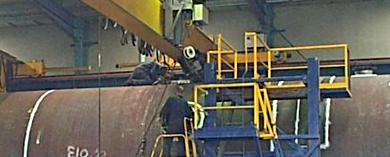
- (03) 5909 8218
- enquiry@fusionweld.com.au
Stresses of Thin Walled Pressure Vessels
July 13, 2016

Thin walled storage containers are widely used in industry. They include many of the stationary vessels installed on large concrete plinths and the lightweight models that transport dangerous pressurised fluids across every nation on our fuel-obsessed globe. In detailing the stresses of thin walled pressure vessels, we're referring to a precisely engineered membrane. This geometrical profile is designed and fabricated with stress distribution in mind. Let's take a closer look at this important thin-skinned storage container.
End Cap Reinforcement
When we talk about the stresses of thin walled pressure vessels, we're referring to fluids exerting pressure on a sealed container, one that's fabricated from curved walls that are less than one-tenth of the diameter of the container. The rolled metal is capped by two heads, end caps that typically use a hemispheroidal form. Other common shapes used in end cap design include the ellipsoidal and torispheroidal form, although a hemisphere is closer to an ideal sphere than the other two shapes. Built to aid in distributing the fluid load, these caps are often reinforced with internal supports, bracing structures that ensure transitional flaws between the cylinder and the head sections are fully eliminated.
Assessing Common Stress Factors
Cylindrical symmetry works cohesively with the welded end caps to evenly distribute the pressurised gas or liquid. The condensed mix is corrosive and potentially explosive. It's also prone to flashing and state changes, so a certain amount of inbuilt flex is mandated here. Hoop stress causes the walls of the cylinder to evenly push outward, for example, while directional stress works on the end sections, thus working at an oblique angle. Therefore, the two different sectional elements should move outward at a different rate. Mechanical deformation would result, but design accountability offsets these competing forces by incorporating a physical continuity feature. Again, it's the shape of the end caps, the addition of internal reinforcing braces, and the quality of the fabrication materials that act as this physical continuity factor.
Of course, the expertise employed by the workshop fabrication facility is also directly influential here. The engineering division counteracts the stresses of thin walled pressure vessels by uniformly distributing pressurised forces. The engineer assesses every juncture, checks every weld point, and reinforces this labour-intensive task by inspecting the final product. The finalised pressure vessel is then certified as a storage unit that can safely deal with hoop stress, shear stress, and all of the other loading factors incurred by the grandly-scaled forces of fluid dynamics.
Contact Details
Fusion - Weld Engineering Pty Ltd
ABN 98 068 987619
1865 Frankston Flinders Road,
Hastings, VIC 3915
Ph: (03) 5909 8218
Optimized by NetwizardSEO.com.au
Recent Posts
- Scheduling Periodic Laundry Boiler Inspections: Best Practices for Plant Managers
- Glycol Regeneration Units - Manufacturing to Optimise Natural Gas Processing
- Skid Mounted Systems for Oil and Gas Industries: Achieve Mobility and Flexibility
- The Role of Transportable Pressure Vessel Inspections in Ensuring Safety
- Periodic Tank In-Service Inspection: How It Maintains Bulk Storage Tank Integrity
- Static Pressure Vessel Manufacturing: Achieve Maximum Reliability
- Pressure Equipment Management by Fusion-Weld: Key Role in Industrial Safety
- Pressure Piping System Inspection: A Gift of Safety for the Holidays
- Deaerator Inspections by Fusion-Weld Engineering and How They Reduce System Downtime
- Bulk Storage Tank Inspection: Protecting Your Essential Assets
- Pipe Spooling Design and Manufacture: Ensuring Accuracy and Fit
Posts 2023
- Pressure Piping System Inspection: A Gift of Safety for the Holidays
- Deaerator Inspections by Fusion-Weld Engineering and How They Reduce System Downtime
- View all articles…
Posts 2022
- How Fusion Weld Keeps Up With AS-NZS ISO 9001:2008 Standard
- Boiler Equipment Safety Inspection During the Summer Season
- View all articles…
Posts 2021
- Avoid These Factors and Practices that Contribute to Sealing Damage in Pressure Vessels
- Do's And Don'ts Of Industrial Boiler Inspection And Maintenance From Fusion-Weld
- View all articles…
Posts 2020
- What are the Risks and Hazards Involved in Pressure Vessel Equipment?
- How to Know if Your Pressure Equipment Needs Repair or Replacement?
- View all articles…
Posts 2019
- Factors that Contribute to Pressure Vessel Failure
- Pressure Vessel Regulations in Australia: What are the Mandatory Requirements?
- View all articles…
Posts 2018
- Pros and Cons of Spherical vs. Cylindrical Pressure Vessels
- What are the Different Hazard Levels in Pressure Vessels?
- View all articles…
Posts 2017
- Transportable Pressure Vessels: The Importance of Inspection and Safety Checks
- Fracture Mechanics and Stress Analysis of Cracks in Pressure Vessels
- View all articles…
Posts 2016
Posts 2015
- What Are Deaerators & Feedwater Vessels?
- Precautions and Safety for Compressed Air Receiver Vessels
- View all articles…
Posts 2014
- Demonstrating In-process Inspection Procedures
- Static Grounding Practices and Standards
- View all articles…